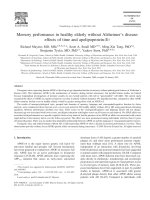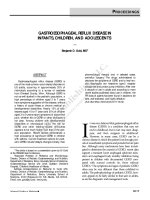Johne’s disease in domestic animals and its zoonotic significance: A review article
Bạn đang xem bản rút gọn của tài liệu. Xem và tải ngay bản đầy đủ của tài liệu tại đây (241.08 KB, 6 trang )
Int.J.Curr.Microbiol.App.Sci (2020) 9(8): 231-236
International Journal of Current Microbiology and Applied Sciences
ISSN: 2319-7706 Volume 9 Number 8 (2020)
Journal homepage:
Review Article
/>
Johne’s Disease in Domestic Animals and its
Zoonotic Significance: A Review Article
Yash Bhargava1, Sushant Sharma2, Amit Singh Vishen3*,
Jagnoor Singh Sandhu4 and Abhishek Mishra5
1
Division of Parasitology, Sher-E-Kashmir University of Agricultural Sciences & Technology
of Jammu, Jammu & Kashmir, India
2
Veterinary officer polyclinic, Dholpur, Rajasthan, India
3
Department of Veterinary Anatomy, C. V. Sc. & A. H., Acharya Narendra Dev University of
Agriculture & Technology, Ayodhya, U.P., India
4
Faculty of Veterinary Sciences & Animal Husbandry, Sher-E-Kashmir University of
Agricultural Sciences & Technology of Jammu, Jammu & Kashmir, India
5
College of Veterinary Sciences & Animal Husbandry, DUVASU, Mathura, India
*Corresponding author
ABSTRACT
Keywords
Johne’s, Crohn’s
disease, Zoonosis
and ruminants
Article Info
Accepted:
10 July 2020
Available Online:
10 August 2020
Johne’s disease is a fatal gastrointestinal disease of ruminants and is caused by the
Mycobacterium avium paratuberculosis (MAP). It is a zoonotic disease and in
humans transmits as Crohn’s disease. The main clinical symptoms of Johne’s
disease in ruminants are Severe diarrhoea with the increased thirst, progressive
cachexia, emaciation, body coat is rough and hide bound condition. Humans can
be exposed to the MAP through the consumption of raw milk of the infected
dairy-herd with the pathogen, ground beef from the infected buffalo, domestic
water supply which is originating from the surface source near the runoff from
infected farms and improper pasteurization of milk. The large intestinal mucosa
becomes cobble stone appearance in Crohn’s disease though it is corrugated in the
JD. The treatment of this disease is not advocated but the vaccination could be
done with heat killed or modified live preparation of Mycobacterium avium
paratuberculosis strain-18. There should be maintenance of personal hygiene and
use of boots, hand gloves and caps during handling of the animals.
after getting infection, though in another side
there are certain diseases whose causative
agent takes time to reflect a clinical sign in
patient after enters the body and starts to
Introduction
There are many infectious diseases which
show early symptoms in domestic animals
231
Int.J.Curr.Microbiol.App.Sci (2020) 9(8): 231-236
damage at cellular and tissue level in the
body. Johne`s disease in ruminants and
Crohn’s disease in humans are two of them,
which are supposed to be caused by same
pathogen and having a good zoonotic
potential. It slowly starts to damage the body
internally and cause the emaciation of the
animals by causing hypoproteinemia. The
farmers of developed and developing
countries will get heavy production losses
from the disease which is generally
undiagnosed in the herds.
eugenic bacteria (the addition of 5% glycerol
causes luxuriant growth) and 5% of CO2 in
the atmosphere aids growth. LowensteinJenson medium, Dorset-egg medium,
Loeffler’s medium, Pawlowsky’s medium,
Tarshi ‘s medium, Middlebrookbiplate agar
media are some of the solid media and Dubos
media, Middlebrooks Proskauer and Beck’s
media, Sula and Sauton’s media are some of
the liquid media used for culture of bacteria.
Biochemical activities evaluated were growth
at 30 °C, 37 °C, and 42 °C; production of
urease, niacin, pyrazinamidase, arylsulfatase,
and catalase; hydrolyzation of Tween 80;
reduction of nitrate and tellurite; and growth
in 5% NaCl. They shed by the infected
animals in the feaces and are wide spread in
soil, pastures, grass and water.
Causative agent and its characteristics
It is a bacterial disease caused by the
Mycobacterium
avium
paratuberculosis
(MAP). They are non-motile, non-spore
forming, aerobic or microaerophilic bacteria.
Ziehl-neelson
stain
(Mangalakumari
Jeyanathan et al., 2006), kynioun stain and
fluorescent stain (Patrick and Houston, 1998)
can be used for staining and diagnosis
purpose. They are known as acid fast
organisms based on their cell wall which
consist of mycolic acids (hydroxy acid
containing caboxyl groups) and overlayed
with a variety of polypeptides and glycolipids.
Both type of innate and adaptive immune
response are activated by this type of cell
wall.
Susceptible species- it is a fatal
gastrointestinal disease of ruminants such as
cattle, buffalo, sheep and goat (Marquetoux et
al., 2018) but generally cattle of age 3-5 years
are more prone to the infection.
Pathogenesis of disease
The disease occurs in three groups- Infected
which do not shed organism in the faeces and
have no clinical disease; infected which shed
organism in the faeces but have no clinical
disease; and infected which shed the organism
in the faeces and have clinical disease.
The classification of bacteriaKingdom- Monera
Phylum- Actinobacteria,
Order- Actinomycetales,
Suborder- Corynebacterineae,
Family- Mycobactericeae,
Genus- Mycobacterin,
Species- Avium,
Subspecies- Paratuberculosis.
Bacteria enters the body of animal through
feco-oral route (Irengea et al., 2008) via
contaminated feed, pasture, water and
generally in acidic soil reaches the intestine.
There it settles in the lamina propria of
intestines or in inside the intestinal mucosa.
The bacteria multiply there and cause
bacteraemia. The bacteria reaches the local
lymphnodes (Christophe Coetsier et al., 1998)
and
cause
chronic
granulomatous
inflammation. It also promotes type-III
hypersensitivity which may contribute to the
They are slow growing bacteria and their
generation time is 14-15 hours and the
optimum pH ranges from 6.4 to 7 and it is
232
Int.J.Curr.Microbiol.App.Sci (2020) 9(8): 231-236
development of intestinal lesions causing
diarrhoea and the hypoproteinemic condition
in the animal.
gastrointestinal tract and can affect any part of
it. Its cure and treatment is poor and do not
give proper result, thus it is a lifelong disease
but not life threatening disease. It generally
affects to 16-25 years age of adults, but
sometimes also occurs in old age and child
hood stages. Symptomatic treatment is
adopted for treatment, surgery could also be
done to remove the affected area/bowel. It can
occur at 24 different sites and on the basis of
these sites the disease is categorized in 24
sub-groups.
The bacteria multiplies in the lining of the
intestine and the associated lymphoid tissue,
but it can also be multiply within the
macrophages which carry the organisms to
other tissues in the animal body and it can
also spread throughout the body but this
condition is rare. Initially cell mediated
immune response is there and later on
antibodies appear likely in response to the
presence
of
Mycobacterium
avium
paratuberculosis by dying macrophages. The
immune response of the animal is responsible
for the diarrhoea in the affected animal. The
bacteria is present in the intestine and the
inflammatory cells respond to the bacteria in
the intestine results in the damage of the
intestinal wall or lining of the animal and it is
interesting to know that the severity of the
disease is reduced or clinical form of the
disease disappear in the pregnant cows as the
immune system is suppressed during the
pregnancy.
Humans can be exposed to the MAP through
the consumption of raw milk of the infected
dairy-herd with the pathogen, ground beef
from the infected buffalo, domestic water
supply which is originating from the surface
source near the runoff from infected farms,
improper pasteurization of milk -HTST. In
1984, Micobacterium paratuberculosis is first
reported from the crohn’s disease patient from
which it is isolated. It is a common disease of
developed rather than undeveloped and
developing countries.
There are certain differences between the
crohn’s disease and Johnes disease- in clinical
stage there is obstruction in Crohn’s disease
while there is no obstruction in the JD in the
intestine, skin lesions are seen in Crohn’s
disease but not seen in JD. The pathological
difference includes the lesions in the oral
cavity and oesophagus in Crohn’s disease.
The macroscopic appearance of bowel wall in
Crohn’s disease is edematous and garden hose
like appearance while in JD it is thickened.
There is stenosis and perforation is there in
Crohn’s disease which is rare in cases of JD.
There is fistula and pseudopolyps in Crohn’s
disease. The mucosa becomes cobble stone
appearance in Crohn’s disease, though it is
corrugated in the JD in large intestine.
Fibrosis and fissures can be seen under
microscope in the histopathological section of
crohn’s disease and acid fast bacilli can be
Clinical signs and its zoonotic importance
Severe diarrhoea with the increased thirst but
the appetite is normal progressive cachexia.
Animal is emaciated, body coat is rough and
hide bound condition appears. The cardinal
symptom of the disease is intermittent or
continuous leading to progressive emaciation
and death (Garvey, 2018).
It is a zoonotic disease and in humans
transmits as Crohn’s disease (Rosenfeld and
Bressler,
2010).
Mycobacterium
paratuberculosis is a bacterium which causes
zoonotic disease and can be transmitted from
bovines to the humans and cause crohn’s
disease. There is general malaise, abdominal
pain, diarrhoea, and chronic weight loss as it
is a chronic inflammatory condition of
233
Int.J.Curr.Microbiol.App.Sci (2020) 9(8): 231-236
seen in the sample for the microscopic lab
diagnosis for JD.
inflammatory cells can be observed under the
microscope the bacterium is observed in
ileocaecal valve smear. There are numerous
foamy macrophages with acid fast organisms
contained in the non-caseting granulomas
(Matos et al., 2017).
Post-Mortem Lesions
Macroscopic lesion: There is thickening of
the terminal part of the ileum and
oedematous. Segmental thickening of the
ileum, caecum, and proximal colon and the
affected segments have a variably thickened,
rough, rugose mucosa, often with multiple
foci of ulceration. There is corrugation in
large intestine. There is lymphadenopathy in
the mesentry. In some cases the vascular
lesion also found as there is mineralization of
aorta and endocardium that is called
arteriosclerosis.
Diagnosis of disease
There are several techniques which aid in
diagnosisRectal smear method,
Laparotomy,
Growth characteristics,
Morphological characteristic,
Genetic identification (by PCR),
ELISA
Complement
Fixation
Test
Standard Test)
Gamma-interferon test
Microscopic lesion: There is infiltration of
epithelioid cells in mucosa, submucosa and in
mesenteric lymphnodes. The thickening of
sub mucosa, oedema and infiltration with
(Gold
Graph.1 Growth curve of Mycobacterium avium subspecies paratuberculosis ('S 5') strain upto
8 weeks by taking OD at 600nm (Auster et al., 2019)
In rectal smear a small piece of the rectum is
pinched out, washed and squeezed between
two slides, the resulting smear and other
smears are stained with Ziehl-Neelsen method
234
Int.J.Curr.Microbiol.App.Sci (2020) 9(8): 231-236
(Allen, 1992). Johne’s bacilli occurs singly
and in characteristic clumps and stain a
pinkish red. In laparotomy a reliable but
complicated procedure to examine smear in
biopsies of mesenteric lymph nodes taken in
the region of the terminal for acid fast
organisms (Hotaling et al., 2001). The gamma
interferon test is based on the animal’s
cellular
immune
response
to
the
Mycobacterium avium paratuberculosis and
this test is able to detect infected animals
before the antibodies start to develop and the
organisms start to shed in the feaces but one
major disadvantage with this test that the
chilled blood sample should be delivered to
the laboratory diagnosis within hours of
collection which is rarely possible in field
condition. The organism grows very slow and
cultivation and identification may take
months the feces or tissue is treated as
contaminants.
avium paratuberculosis strain-18 can be used
for sheep and goat (Park and Yoo, 2016). Calf
from the dam is completely separated from
the lactating and dry herd. The lactating and
dry herd should be completely separated from
the maternity area. All the milking equipment
should be properly cleaned and disinfected
daily as because the bacteria also shed in the
milk. Sheds should be cleaned frequently and
well
drained.
Raise
the
pH
of
environment/soil with lime. Drainage from
the sheds should not be towards the pasture
land. Sometimes the bacteria sheds in the
semen so bulls should tested before semen
collection. There should be maintenance of
personal hygiene and use of boots, hand
gloves, caps during handling of the animals.
Milk should be consumed after pasteurization
by HTST method (Eslami et al., 2018).
Dispatch of the clinical sample
Allen, J.L. 1992. A modified Ziehl-Neelsen
stain for mycobacteria. Medical
laboratory sciences, 49(2): 99-102.
Auster, L., Sutton, M., Gwin, M.C., Nitkin, C.
and Bonfield, T.L. 2019. Optimization
of In Vitro Mycobacterium avium and
Mycobacterium intracellulare Growth
Assays for Therapeutic Development.
Microorganisms, 7(2): 42.
Christophe C., Xavier H., Francois M., Sanaa
S., Francoise C., Klaus B., Bernard L.,
Dominique L., Herve B., Jean F.D. and
Carlo C. 1998. Clinical and Diagnostic
Laboratory Immunology, Jul 5 (4): 446451.
Savarino E. , Bertani L., Ceccarelli L., Bodini
G., Zingone F., Buda A., Facchin S.,
Lorenzon G., Marchi S., Marabotto E.,
Bortoli D.N., Savarino V. , Costa F. and
Blandizzi C. 2019. Antimicrobial
treatment with the fixed dose antibiotic
combination
RHB-104
for
Mycobacterium
avium
subspecies
paratuberculosis in Crohn’s disease:
References
Rectal pinch swab or smear, fecal sample,
terminal portion of ileum with ileocaecal
valve, mesenteric lymph gland in 10% formal
saline will be sample of choice for dispatch.
In case of delay if material is collected for
bacteriological examination then it should be
kept at refrigeration temperature.
Treatment of disease
The combination of streptomycin, rifampicin
and levamisole is used but they are not cost
effective and the infection again develops
after discontinuation of the drugs, thus test
and slaughter policy is adopted for it.
Therefore treatment of this disease is not
advocated (Savarino et al., 2019).
Vaccination and control
Vaccination could be done; heat killed or
modified live preparation of Mycobacterium
235
Int.J.Curr.Microbiol.App.Sci (2020) 9(8): 231-236
pharmacological
and
clinical
implications, Expert opinion on
biological therapy.
Eslami, M., Shafiei, M., Ghasemian, A. 2018.
Mycobacterium avium paratuberculosis
and Mycobacterium avium complex and
related subspecies as causative agents of
zoonotic and occupational diseases. J
Cell Physiol., 234: 12415– 12421
Mangalakumari J., David C. Alexander,
Christine Y. T., Christiane G., Marcel
A. 2006. Evaluation of In Situ methods
used to Detect Mycobacterium avium
subsp. paratuberculosis in Samples
from Patients with Crohn’s Disease
Behr Journal of Clinical Microbiology,
44 (8) 2942-2950.
Garvey, M. 2018. Mycobacterium avium
subspecies paratuberculosis: A possible
causative agent in human morbidity and
risk to public health safety. Open
veterinary journal, 8(2): 172–181.
Léonid M. Irenge, Karl Walravens, Marc
Govaerts, Jacques Godfroid, Valérie
Rosseels,
et
al.,
Development,
validation of a triplex real-time PCR for
rapid
detection
and
specific
identification of M. avium subsp.
paratuberculosis in faecal samples.
Veterinary Microbiology, Elsevier,
2009,
136
(1-2),
pp.166.
ff10.1016/j.vetmic.2008.09.087ff. ffhal00532519f
Marquetoux, N., Mitchell, R., Ridler, A. et
al., A synthesis of the patho-physiology
of Mycobacterium avium subspecies
paratuberculosis infection in sheep to
inform mathematical modelling of ovine
paratuberculosis. Vet Res 49, 27 (2018).
Matos, A. C., Figueira, L., Martins, M. H.,
Matos, M., Álvares, S., Mendes, A.,
Pinto, M. L., and Coelho, A. C. (2017).
Detection of Mycobacterium avium
subsp. paratuberculosis in kidney
samples of red deer (Cervus elaphus) in
Portugal: Evaluation of different
methods. The Journal of veterinary
medical science, 79(3), 692–698.
Park, H. T., and Yoo, H. S. (2016).
Development
of
vaccines
to
Mycobacterium
avium
subsp.
paratuberculosis infection. Clinical and
experimental vaccine research, 5(2),
108–116.
Ramage, G., S. Patrick, and S. Houston. 1998,
Combined
fluorescent
in
situ
hybridisation and immunolabelling of
Bacteroides
fragilis.
Journal
of
immunological methods 212:139-147.
Rosenfeld, G., and Bressler, B. (2010).
Mycobacterium avium paratuberculosis
and the etiology of Crohn’s disease: a
review of the controversy from the
clinician's
perspective.
Canadian
journal of gastroenterology = Journal
canadien de gastroenterologie, 24(10),
619–624.
Somoskövi A, Hotaling JE, Fitzgerald M, et
al., Lessons from a proficiency testing
event for acid-fast microscopy. Chest.
2001 Jul;120(1):250-257.
How to cite this article:
Yash Bhargava, Sushant Sharma, Amit Singh Vishen, Jagnoor Singh Sandhu and Abhishek
Mishra. 2020. Johne’s Disease in Domestic Animals and its Zoonotic Significance: A Review
Article. Int.J.Curr.Microbiol.App.Sci. 9(08): 231-236.
doi: />
236









